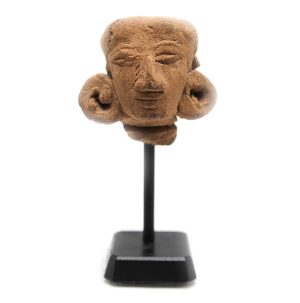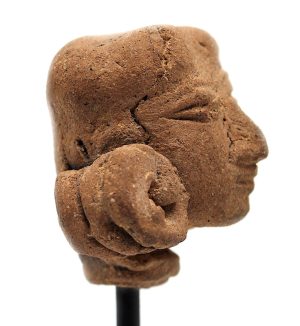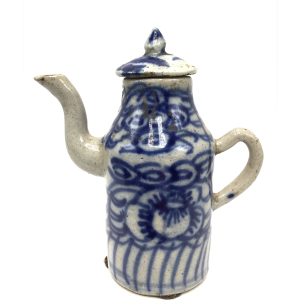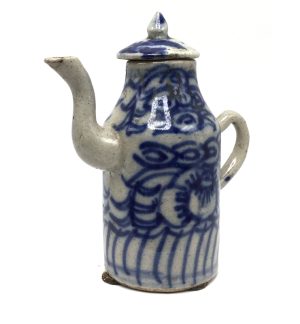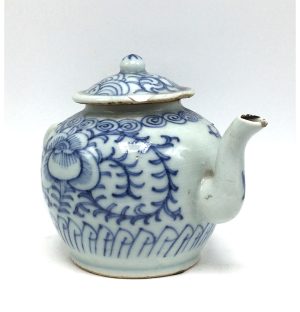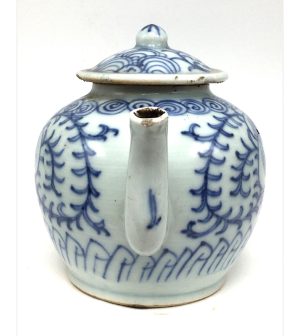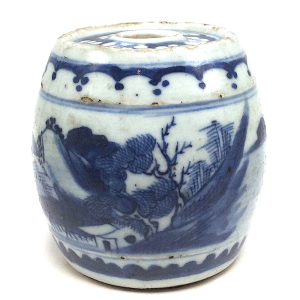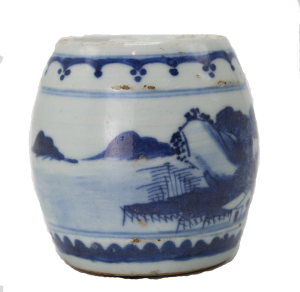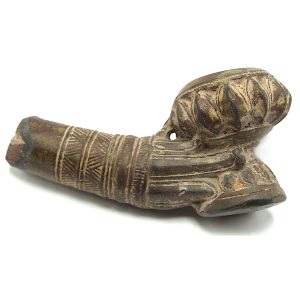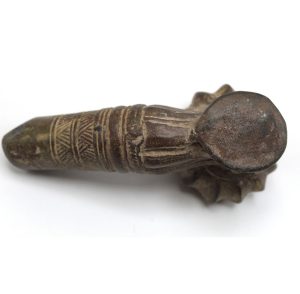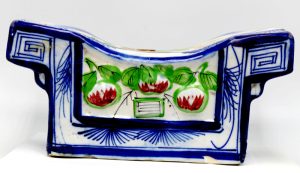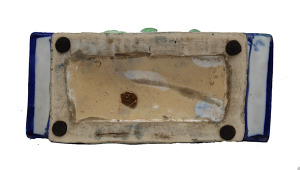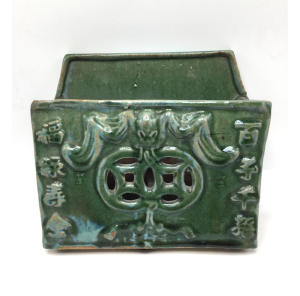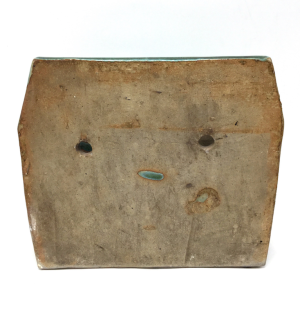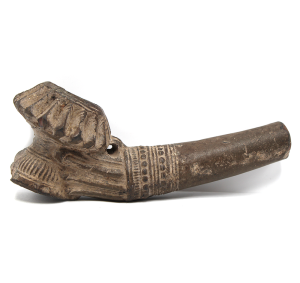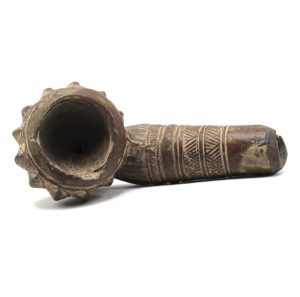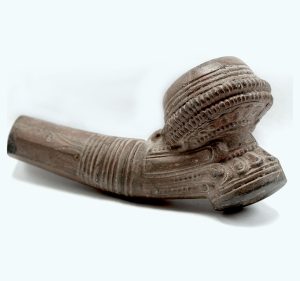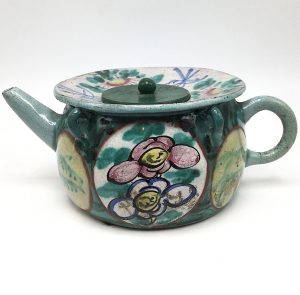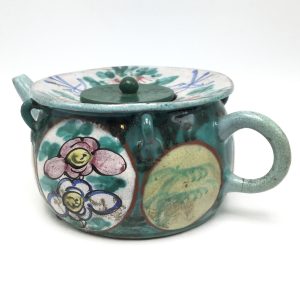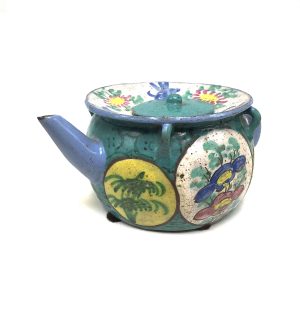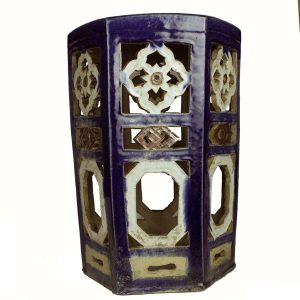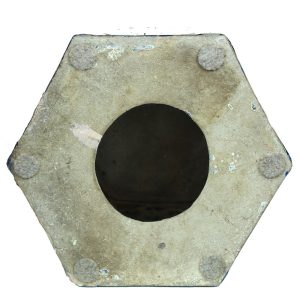Showing 1–12 of 45 results
-


$195.00
Ht: 2.75” W: 1.375” D:1.125” | FREE SHIPPING WITHIN CONTIMENTAL U.S.!
This terracotta head was crafted during the Majapahit Empire in Java and was either part of a bas-relief frieze or made as a freestanding figurine. Most figures found are small decapitated heads with no bodies, and it is very rare to find a complete figure with a naturalistic facial expression. As with many heads, this one displays Javanese facial features, hairstyles and ear ornamentation typical of the period. It has a naturalistic facial expression and wears large round coiled earrings, possibly suggesting it represented someone of the upper classes. It is in very good condition given its age and use and is mounted on a metal stand. This item pairs with Majapahit Miniature Terracotta 1138.
-


$135.00
H: 5.25″ W: 4.625″ D: 2.375″ | FREE SHIPPING WITHIN CONTINENTAL U.S.!
This charming miniature ewer or small pitcher was made during the Tongzhi Period and probably used in a restaurant or home kitchen as a dispenser for soy sauce, oils or other liquids. With an elegantly curved spout and handle it is covered with chrysanthemums, plantain curved vertical leaves and bindweed vines. The lid has a lotus shaped bud for lifting, and the bottom has a Chinese antique export seal.
-
Sale!


$175.00 Original price was: $175.00.$115.00Current price is: $115.00.
H: 5.25” W: 4.75” D: 2.375” | FREE SHIPPING IN CONTINENTAL US!
This elegantly shaped small teapot has finely painted cobalt blue chrysanthemum and bindweed designs in the center and upper registers and plantain leaf designs at the bottom, popular underglaze design elements were widely used in late 19th century in domestic and export wares. Below the short neck is a chain of roundels with nineteen spirals, and the lid is covered with bindweed and wave designs, the latter indicating a sea or lake. The lid is topped by a ball handle topped with a four-line star and the bottom has an abstract plantain leaf design. It is in very good condition with two small chips on the lid and a small chip on the end of the spout. The inside has been stained by more than a century of tea brewing.
-


$255.00
H: 3.25” Dia: 3.25” | FREE SHIPPING WITHIN CONTINENTAL U.S.!
This is unusual piece was likely on a scholar’s desk along with pots, brushes, water droppers, boxes, ink stones and other daily used objects used for a variety of tasks: a brush holder, a paper weight and more. With its round body covered with the landscape of a Chinese village, mountains and seas and the calligraphic name of the scholar owner Shu Dai Ji (舒逮吉) it would be perfect for placement on any style desk or in a study.
-


$85.00
H: 2” W: 1.75” D: 4” | FREE SHIPPING WITHIN CONTINENTAL U.S.!
Antique and vintage ceramic tobacco pipes are part of a long cultural tradition of Burmese/Myanmar and Thai hill tribes. Mould made and adorned with intricate designs, a bamboo or metal stem was often inserted at the end through which smoke was drawn. This highly collectible antique item reflects hill-tribe skills creating decorative functional objects and would be a unique gift for any pipe smoker, but, like all antique items, we recommended it be used as a decorative item.
-


$105.00
H: 4″ W: 9.5″ D: 4.5 ” | FREE SHIPPING!
This charming fanciful vintage underglaze blue and white porcelain pillow has added hand-painted green and red florals, fruits and vases in relief within framed geometric borders of blue cobalt oxide pigment. The top curves in the center to cradle the neck for comfort and flares outward. The front and back sides have charming painted relief images of vases on the front and fruit on the back. The top and bottom have seals applied to Chinese antiques indicating they were approved for export. There is a slight chip on the front, otherwise it is in excellent condition.
-
Sale!


$185.00 Original price was: $185.00.$145.00Current price is: $145.00.
H: 7.125″ W: 8.375″ D: 3.75″ | FREE SHIPPING WITHIN CONTINENTAL U.S.
This Shiwan green chopsticks holder is divided into two parts with holes on top for hanging and small holes on the bottom for drainage. Chopsticks were often wedding gifts from mothers to daughters with many auspicious wishes: phrases for sons as soon as possible, upside down bats with coins and ribbon meaning “blessings in front of your eyes,” and border clouds and thunder symbolizing life-giving rain and abundance.
-


$105.00
H: 1.875” W: 1.75” D: 4” | FREE SHIPPING!
Antique and vintage ceramic tobacco pipes are part of a long cultural tradition of Burmese/Myanmar and Thai hill tribes. Mould made and adorned with intricate designs, a bamboo or metal stem was often inserted at the end through which smoke was drawn. This highly collectible antique item reflects hill-tribe skills creating decorative functional objects and would be a unique gift for any pipe smoker, but, like all antique items, we recommended it be used as a decorative item.
-


$85.00
H: 2” W: 1.75” D: 4” | FREE SHIPPING!
Antique and vintage ceramic tobacco pipes are part of a long cultural tradition of Burmese/Myanmar and Thai hill tribes. Mould made and adorned with intricate designs, a bamboo or metal stem was often inserted at the end through which smoke was drawn. This highly collectible antique item reflects hill-tribe skills creating decorative functional objects and would be a unique gift for any pipe smoker, but, like all antique items, we recommended it be used as a decorative item.
-
Sale!


$365.00 Original price was: $365.00.$295.00Current price is: $295.00.
H: 2.625” W: 6.125” D: 4” | FREE SHIPPING WITHIN CONTINENTAL U.S.!
This delicate antique Yixing teapot is unusually shaped with a loop handle, short spout, flaring rim, small flat cover and small loops below its rim that indicate it may have been used to suspend oil or soy sauce rather than serve tea. Its charm is enhanced by its free hand-painted colored enamels with 6 circular panels containing fanciful and bright floral and leaf decorations. Chinese tea connoisseurs consider Yixing teapots the best vessel for brewing tea as it is naturally porous to absorb oils released during brewing and improves tea’s flavor with continual use. Recommended for display only, it pairs well with 1152A-PAR Enameled Yixing Stoneware Teapot.
-
Sale!


$365.00 Original price was: $365.00.$295.00Current price is: $295.00.
H: 2.6 ” W: 6.1 ” D: 4 ” | FREE SHIPPING WITHIN CONTINENTAL U.S.!
This delicate antique Yixing teapot is unusually shaped with a loop handle, short spout, flaring rim, small flat cover and small loops below its rim that indicate it may have been used to suspend oil or soy sauce rather than serve tea. Its charm is enhanced by its free hand-painted colored enamels with 6 circular panels containing fanciful and bright floral and leaf decorations. Chinese tea connoisseurs consider Yixing teapots the best vessel for brewing tea as it is naturally porous to absorb oils released during brewing and improves tea’s flavor with continual use.
-


$1,450.00
The top design on this stoneware garden stool is a simplified open narcissus with a white and yellow center; it is a symbol of good fortune and prosperity. Below are intertwined double lozenges, followed on the lowest register of by white octagonal shapes and ending with a low orange-yellow rectangle pierced in the center. A…
End of content
End of content

